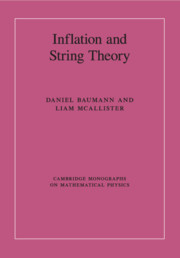Book contents
- Frontmatter
- Dedication
- Contents
- Preface
- Notation and conventions
- 1 Inflation: theory and observations
- 2 Inflation in effective field theory
- 3 Elements of string theory
- 4 What is string inflation?
- 5 Examples of string inflation
- 6 Conclusions and outlook
- Appendix A Mathematical preliminaries
- Appendix B The effective theory of inflation
- Appendix C Primordial perturbations from inflation
- References
- Index
5 - Examples of string inflation
Published online by Cambridge University Press: 05 May 2015
- Frontmatter
- Dedication
- Contents
- Preface
- Notation and conventions
- 1 Inflation: theory and observations
- 2 Inflation in effective field theory
- 3 Elements of string theory
- 4 What is string inflation?
- 5 Examples of string inflation
- 6 Conclusions and outlook
- Appendix A Mathematical preliminaries
- Appendix B The effective theory of inflation
- Appendix C Primordial perturbations from inflation
- References
- Index
Summary
In this chapter, we will survey a number of representative examples of inflation in string theory. We will try to be reasonably complete in our discussion of inflationary mechanisms, within the limitations of space and expertise, but we will not be able to present all of the results in the subject. Our focus will be on extracting a few important lessons from the collective works of many researchers.
The individual sections are largely self-contained and can be read in any order. In Section 5.1, we consider the motion of a D3-brane [627] in a warped throat region [42] as a source for inflation. We present a number of interrelated perspectives on the potential energy of a D3-brane in a warped flux compactification, and then discuss the challenge of achieving slow-roll behavior in this setup. In Section 5.2, we study a few examples of brane inflation in unwarped compactifications, including D3/D7 inflation [628–632], fluxbrane inflation [633, 634], and M5-brane inflation [635, 636]. In Section 5.3, we discuss relativistic brane motion as a source of non-slow-roll inflation. We describe DBI inflation [39] as an effective field theory and highlight microphysical constraints imposed by compactification. In Section 5.4, we argue that string axions are promising inflaton candidates. We give detailed analyses of N-flation [549] and axion monodromy inflation [35]. In Section 5.5, we describe models in which the inflaton is a Käahler modulus (or the associated axion), including racetrack inflation [637, 638] and inflationary scenarios in large volume compactifications [44, 639, 640]. Finally, in Section 5.6, we look at dissipative effects as a source of inflation and critically assess the prospects for dissipative inflation in string compactifications [641–644].
Inflating with warped branes
The positions of localized sources in a string compactification correspond to scalar fields in the four-dimensional effective theory. In [627], Dvali and Tye proposed that the separation between two branes could serve as an inflaton candidate.
- Type
- Chapter
- Information
- Inflation and String Theory , pp. 157 - 261Publisher: Cambridge University PressPrint publication year: 2015



